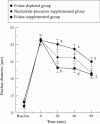Folate depletion impairs DNA excision repair in the colon of the rat
- PMID: 9771411
- PMCID: PMC1727179
- DOI: 10.1136/gut.43.1.93
Folate depletion impairs DNA excision repair in the colon of the rat
Abstract
Background/aims: Diminished folate status appears to promote colonic carcinogenesis by, as of yet, undefined mechanisms. Impaired DNA repair plays a significant role in the evolution of many colon cancers. Since folate is essential for the de novo synthesis of nucleotides and since folate depletion has previously been associated with excessive DNA strand breaks, it was hypothesised that folate depletion may impair DNA repair. Studies were therefore performed to examine whether folate depletion affects the two major categories of DNA repair.
Methods: Study 1: eight weanling male Sprague-Dawley rats were fed on diets containing either 0 or 8 mg folate/kg diet with 1% succinylsulphathiazole for four weeks. After viable colonocytes had been harvested, DNA excision repair was evaluated by a single cell gel electrophoresis assay. Study 2: eighteen animals were fed on similar diets for five weeks. Also in study 2, 18 additional rats were fed on the same defined diet without succinylsulphathiazole for 15 weeks. Weekly injections with the procarcinogen, 1,2-dimethylhydrazine (20 mg base/kg), were administered to the latter group of animals. Five microsatellite loci from different chromosomes were investigated for instability in hepatic and colonic DNA.
Results: In study 1, a significantly retarded rate of DNA excision repair was observed in the folate deficient colonocytes compared with controls (p < 0.05). In study 2, there was no evidence of instability at the five microsatellite loci associated with either short or long term folate depletion.
Conclusions: Folate deficiency impairs DNA excision repair in rat colonic mucosa; a similar degree of deficiency, even when administered in conjunction with a colonic carcinogen, did not produce evidence of a widespread defect in mismatch repair.
Figures


References
Publication types
MeSH terms
Substances
Grants and funding
LinkOut - more resources
Full Text Sources
Medical
